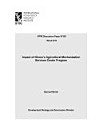Protected agriculture, precision agriculture, and vertical farming: Brief reviews of issues in the literature focusing on the developing region in Asia
Takeshima, Hiroyuki · Joshi, Pramod Kumar
Mär 2019 · IFPRI Discussion Paper Buch 1814 · Intl Food Policy Res Inst
3.0star
2 Rezensionenreport
E-Book
49
Seiten
family_home
Zulässig
info
reportBewertungen und Rezensionen werden nicht geprüft Weitere Informationen
Über dieses E-Book
The frontiers of technologies have been constantly expanded in many industries around the world, including the agricultural sector. Among many “frontier technologies” in agriculture, are protected agriculture, precision agriculture, and vertical farming, all of which depart substantially from many conventional agricultural production methods. It is not yet clear how these technologies can become adoptable in developing countries, including, for example, South Asian countries like India. This paper briefly reviews the issues associated withthese three types of frontier technologies. We do so by systematically checkingthe academic articleslisted in Google Scholar, which primarily focus on these technologies in developing countries in Asia. Where appropriate, a few widely-cited overview articles for each technology were also reviewed. The findings generally reveal where performances of these technologiescan be raised potentially, based on the general trends in the literature. Where evidence is rich, some generalizable economic insights about these technologies are provided. For protected agriculture, recent research has focusedsignificantly on various features of protective structures (tunnel heights, covering materials, shading structures, frames and sizes) indicating that there are potentials for adaptive research on such structures to raise the productivity of protected agriculture. The research on protected agriculture also focuses on types of climate parameters controlled, andenergy structures, among others. For precision agriculture, recent research has focused on the spatial variability of production environments, development of efficient and suitable data management systems, efficiency of various types of image analyses and optical sensing, efficiency of sensors and related technologies, designs of precision agriculture equipment, optimal inputs and service uses, and their spatial allocations, potentials of unmanned aerial vehicles (UAVs) and nano-technologies. For vertical farming, research has often highlighted the variations in technologies based on out-door / indoor systems, ways to improve plants’ access to light (natural or artificial), growing medium and nutrient / water supply, advanced features like electricity generation and integration of production space into an office / residential space, and water treatment. For India, issues listed above may be some of the key areas that the country can draw on from other more advanced countries in Asia, or can focus in its adaptive research to improve the relevance and applicability of these technologies to the country.
Bewertungen und Rezensionen
3.0
2 Rezensionen
Autoren-Profil
Dieses E-Book bewerten
Deine Meinung ist gefragt!
Informationen zum Lesen
Smartphones und Tablets
Nachdem du die Google Play Bücher App für Android und iPad/iPhone installiert hast, wird diese automatisch mit deinem Konto synchronisiert, sodass du auch unterwegs online und offline lesen kannst.
Laptops und Computer
Im Webbrowser auf deinem Computer kannst du dir Hörbucher anhören, die du bei Google Play gekauft hast.
E-Reader und andere Geräte
Wenn du Bücher auf E-Ink-Geräten lesen möchtest, beispielsweise auf einem Kobo eReader, lade eine Datei herunter und übertrage sie auf dein Gerät. Eine ausführliche Anleitung zum Übertragen der Dateien auf unterstützte E-Reader findest du in der Hilfe.










